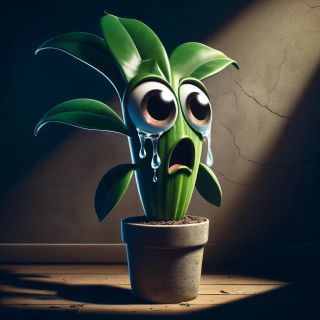Biophilia
Do Plants Care What Happens to Them?
Recent evidence suggests that plants can cry, mourn, and feel pain. What does that mean for us?
Posted June 3, 2024 Reviewed by Devon Frye
Key points
- Plants may actually be sentient beings.
- Researchers can now hear the cries plants make; they emit high-frequency noises.
- Learning compassion for non-human plants and animals may help us learn compassion for each other.
Did you know that acacia trees in Africa cry out when giraffes eat their leaves? (Downing et al., 2020). Did you know that chopping off the limb of a tree can cause it to suffer terribly? Perhaps you have transplanted a plant or tree only to watch it die from the shock of transplantation.
Here’s something you probably didn’t know: Trees form attachments with other trees much like social animals do. Chop down a tree’s companion tree and the surviving tree will probably die too—very much like when someone as old as me loses his lifelong partner (Schiffman, 2016).
Wait, you say. Plants don’t actually care what happens to them, do they? Or do they?

Evidence of Plant Sentience
They do. Apparently, they have always cared, but we assumed they didn’t. Scientists now know that plants do not go quietly away, any more than an animal in an abattoir would quietly let itself get slaughtered. We just didn’t know how to hear them until recently.
Not long ago, the famous Jaak Panksepp discovered that rats giggle and scream—but we couldn’t hear them either (Panksepp, 2007). Now we know they that they do (because he used a high-frequency listening device, normally used with bats, to hear them play).
Scientists in Tel Aviv, Israel ran a series of tests just to see whether plants could cry out when stressed or “in pain” (Starr, 2023). They found that plants cry out the same way animals do when they are in pain. We just couldn’t hear them before, because we can’t hear the high-frequency sounds they make in response to their suffering.
Other animals can hear them, however. Over the millennia, they have forged ancient relationships with these species to the benefit of both. This is called symbiosis. It turns out that plants emit popping noises at frequencies too high for humans to hear. And they also emit chemical signals that mean something to other plants and animals (even if they don’t mean anything to us). This is how they scream—whenever they are in anguish, under too much stress, abused, deprived of water, or injured.
That really hits home when I think how we humans regard them—as mechanical beings without a soul or feelings. We have blindly viewed them, across time, as conveniently here for us, and just as conveniently wanting nothing from us in return. So we mow them down, or eat them, or prune them without the benefit of anesthesia, or pull them out by the roots to get them out of our way. It may further amaze you to learn that they scream to warn their “next of kin” too, to try and save their friends even if they can’t save themselves (Tikkanen, 2024).
Symbiosis and Amensalism
Giraffes have coexisted with acacia trees for a very long time. Scientists call this form of symbiosis commensalism (when both species benefit). Both species survive because giraffes find these chemical cries for mercy very unpleasant—so they stop eating the acacia before they can wipe them all out. If not for this social outcry, giraffes would soon eat all the leaves on every tree (and wipe out their favorite food source).
Does this sound familiar? It should. Humans have been exploiting their favorite things for millennia, many of which have gone extinct. That’s because we are very different from most species in that, rather than learning to respect these natural boundaries the rest of nature respects, we invent clever ways to overcome them. That way we can keep on eating or wiping them out, even when they cry out, and even when they evolve mechanisms to try and avoid being eaten or destroyed.
Scientists call this relationship between humans and plants amensalism—when only one species benefits from the other, apparently not caring what happens to the species it exploits (Meinecke, 2017). Until about a hundred years ago, we treated all animals and plants this way—a one-sided relationship in which we take from them and give nothing back.
Plants now join mammals, ants, bees, and social fish in the ever-growing number of living things that can feel anguish, express pain, and warn their own kind of imminent extinction—even if they realize they can’t save themselves. How human these behaviors are!
Reverence for Flowers
You are probably wondering, what does this have to do with psychology? Plants don’t have thoughts, do they? Probably not. But you and I do. This, then, is why it matters to me.
In my research, I have found evidence that how we think about other species governs how we see other human beings too. When we learn to look down on plants and animals as inferior, we also learn to look down on human beings we don’t identify with as inferior. We generalize our disregard, holding ourselves to be special and others as meant to be excluded or mistreated (just as we view animals and plants).
Many studies have been conducted on this, and the way we behave very much supports this finding. If we learn there is a “predetermined difference” between the preciousness of humans and the preciousness of other animals on this planet (and now plants), we will unconsciously apply this belief to anyone who gets in our way. This is called dehumanization (Plous, 2003).
But there is hope. Researchers also tested to see if children taught that animals are just as precious as people might be more open to people of different races and cultures.
The finding? If we teach our children to treat all species with the same high regard, they will grow up to treat other races better than we do now. By simply learning to see animals with more reverence, children learned to see immigrants with more reverence too (Costello & Hodson, 2014).
Imagine then, if you and I could learn to revere the flowers that seem common and valueless, as caring about how we treat them? Wouldn’t we generalize this regard to our own species too? (Markey & Meinecke, 2020).
No Man Ever Yet Hated Himself
We believe that only humans have feelings. I find that belief counterfactual—because, if we do, why do we have no feelings for other animals? Why do we have no feelings for living things we have classified as “invertebrates” or “plants”? Why do we feel nothing for plants when many other species do?
The famous robot scientist Pentti Haikonnen once told me that, if you want to know if something is part of you, pinch it. If it hurts, it’s you.
That was so meaningful to me as a doctoral student. It always made me think. Maybe it should hurt when we cut the roses. Maybe it should sting when we sting our cattle with prods. The flowers, the cattle, and sea, and the land are all part of a living organism we call our home (Wilson, 2016).
We have just stopped listening to anything but our own voices. We have forgotten a language that everything seems to speak except humans, as we obstinately plow under the homes of anything that doesn’t look and act like us. But if we listen closely, we can hear a host of tiny voices all around us—it’s our chance to learn how to treat each other well by learning to treat all things, great and small, well.
References
Costello, K., & Hodson, G. (2014). Explaining dehumanization among children: The interspecies model of prejudice. British Journal of Social Psychology, 53(1), 175-197. doi:10.1111/bjso.12016
Downing, A., Atwell, B., Marais, K., & Downing. K. Acacia v. Giraffe. Macquarie University. Retrieved from http://bio.mq.edu.au/wp-content/uploads/2020/09/Plant-of-the-week-Acacia-v-Giraffe.pdf
Markey, M. A. & Meinecke, L. M. (2020). Examining biophilia and societal indifference to environmental protection. Hershey, PA: IGI Global Publishing. doi:10.4018/978-1-7998-4408-2
Meinecke, L. D. (2017). Neglected by assessment: Industry versus inferiority in the competition for scarce kidneys. (Doctoral dissertation). Available from ProQuest Dissertations and Theses database. (ProQuest No. 10689852)
Panksepp, J. (2007). Neuroevolutionary sources of laughter and social joy: Modeling primal human laughter in laboratory rats. Behavioural Brain Research, 182(2), 231–244. Retrieved from https://www.researchgate.net/
Plous, S. (2003). Is there such a thing as prejudice toward animals? In S. Plous (Ed.), Understanding Prejudice and Discrimination (1st ed., pp. 509-528). Boston, MA: McGraw-Hill.
Schiffman, R. (2016, November 16). Are trees sentient beings? Certainly, says German forester. Retrieved from https://e360.yale.edu/features/are_trees_sentient_peter_wohlleben
Starr, M. (September 1, 2023). Plants really do 'scream'. We just never heard It until now. Nature. Retrieved from https://www.sciencealert.com/plants-really-do-scream-we-just-never-heard-it-until-now
Tikkanen, A. (2024). Alarm signal (zoology). Retrieved from https://www.britannica.com/science/alarm-signal-zoology
Wilkin, J. (2021, March 23). Transplant shock - helping your tree recover. Retrieved from https://www.yourleaf.org/blog/jess-wilkin/mar-23-2021/transplant-shock-helping-your-tree-recover
Wilson, E. O. (2016). Half-earth: Our planet's fight for life. New York, NY: Liveright Publishing.



